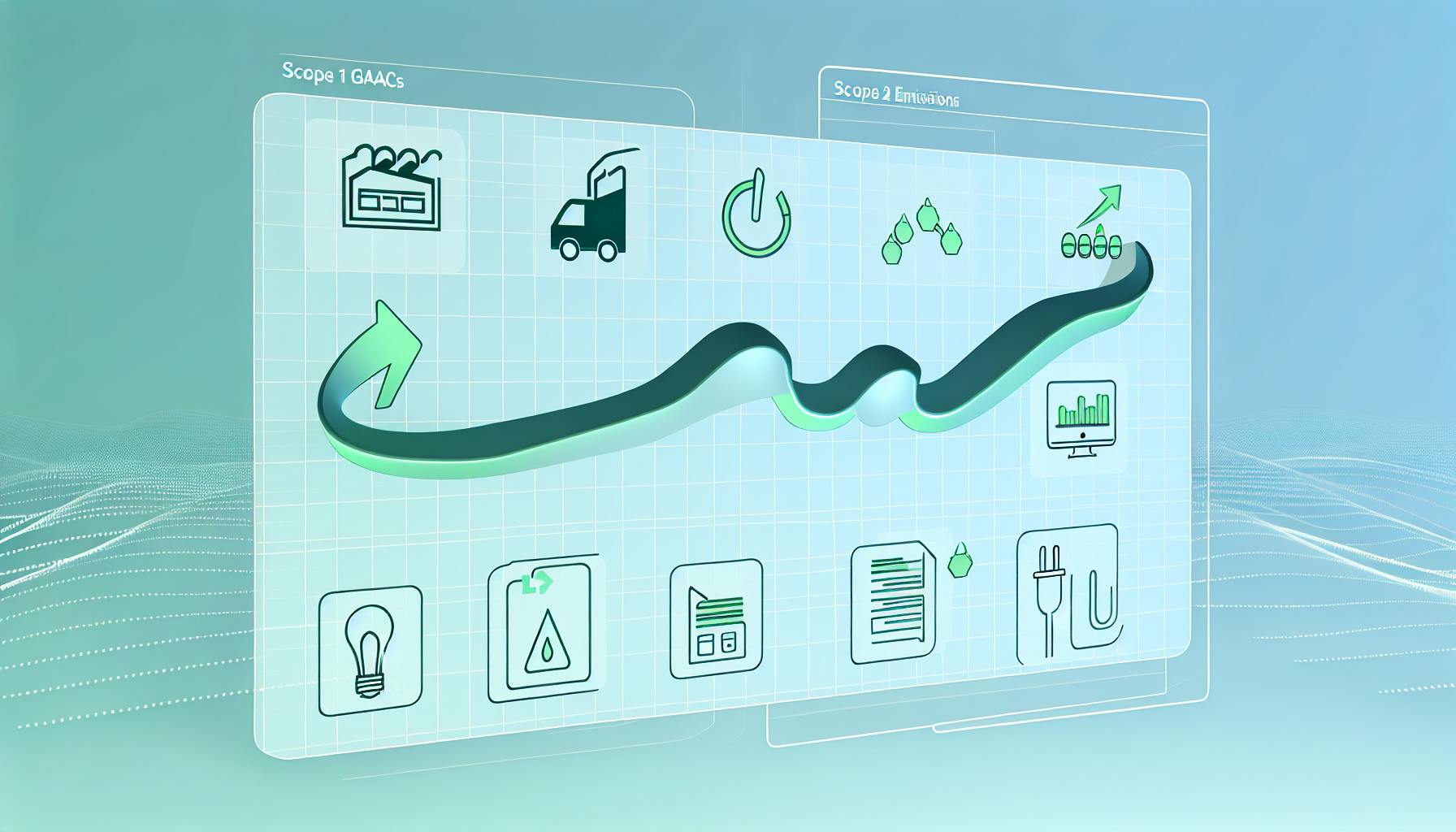Reporting carbon emissions can feel overwhelming for small and medium enterprises (SMEs).
This article will demystify the process by breaking down the key carbon reporting protocols and simplifying the technical aspects specifically for SMEs.
You'll learn the fundamentals of prominent standards like the Greenhouse Gas (GHG) Protocol, find clarity on scopes 1, 2 and 3, and discover digital tools to integrate sustainability reporting into your operations - all aimed at enhancing transparency and accuracy when communicating with stakeholders.
Demystifying Carbon Protocol Reporting for SMEs
The Essence of Carbon Protocol Reporting
Carbon protocol reporting provides a standardised framework for SMEs to accurately measure, disclose, and reduce their greenhouse gas (GHG) emissions. As stakeholders demand increased climate action and transparency, following established protocols helps SMEs clearly communicate their sustainability efforts. The key benefit lies in simplifying the technical complexities of carbon accounting.
GHG Protocol: The Foundation of Carbon Reporting
The Greenhouse Gas (GHG) Protocol establishes comprehensive global standards for calculating and reporting GHG emissions. Its Corporate Standard and Scope 3 Standard enable SMEs to:
- Identify all emission sources
- Correctly determine organisational boundaries
- Improve reporting consistency across operations and value chain
Adoption of the GHG Protocol enhances the credibility of SMEs' sustainability claims for both internal and external stakeholders.
The Role of Accurate Carbon Disclosure in Stakeholder Engagement
Accurate carbon disclosure as per leading protocols builds trust and clarity around sustainability initiatives. It:
- Demonstrates commitment through robust emissions measurement
- Identifies areas for targeted reductions
- Enables performance tracking over time
- Substantiates sustainability claims with reliable data
Such transparency and accountability help SMEs effectively engage stakeholders on their decarbonisation journey.
Decoding GHG Protocol Scope 1, 2, and 3 for SMEs
The GHG Protocol categorizes emissions into three scopes:
- Scope 1 covers direct emissions from owned/controlled sources like facilities, and vehicles.
- Scope 2 accounts for indirect emissions from purchased electricity/steam.
- Scope 3 includes value chain emissions from activities like procurement, and distribution.
Understanding the differences allows SMEs to report emissions accurately across their operations and supply chain. Tracking Scope 3 specifically helps identify hotspots for partnering with vendors/customers on reductions.
Following carbon protocols thus provides structured guidance for SMEs communicating their sustainability credentials clearly.
What is the carbon gas protocol?
The Greenhouse Gas (GHG) Protocol provides globally recognized standards for measuring and managing greenhouse gas (GHG) emissions from private and public sector operations, value chains, products, cities, and policies.
Developed through a multi-stakeholder partnership convened by the World Resources Institute (WRI) and the World Business Council for Sustainable Development (WBCSD), the GHG Protocol standards enable organisations to identify, calculate, and report GHG emissions in a consistent and credible manner.
There are two key GHG Protocol standards used by businesses and governments:
- The Corporate Accounting and Reporting Standard: Provides requirements and guidance for companies and other organizations to prepare a corporate-level GHG emissions inventory. It covers the accounting and reporting of the six greenhouse gases covered by the Kyoto Protocol — carbon dioxide (CO2), methane (CH4), nitrous oxide (N2O), hydrofluorocarbons (HFCs), perfluorocarbons (PFCs), and sulfur hexafluoride (SF6).
- The Corporate Value Chain (Scope 3) Accounting and Reporting Standard: Supplements the Corporate Standard by providing further guidance on how to account for value chain emissions, also known as Scope 3 emissions. It covers indirect emissions from upstream and downstream activities in a company's value chain.
By providing a standardised approach to emissions calculations and reporting, the GHG Protocol enables accuracy and clarity in communicating an organization's carbon footprint and sustainability efforts to stakeholders. Its methodology simplifies the complex technical aspects of carbon accounting and carbon protocol reporting for both large enterprises and SMEs.
What is the carbon neutral protocol 2023?
The CarbonNeutral Protocol 2023 provides a detailed framework for organisations to design and implement credible carbon neutral programs. It underpins the CarbonNeutral certifications awarded by Climate Impact Partners to recognise carbon neutral organisations, products, and activities.
The key aspects of the CarbonNeutral Protocol 2023 include:
- Defining carbon neutrality - The protocol clearly defines what it means for an organization, product, or activity to be carbon neutral. This includes offsetting all unavoidable greenhouse gas (GHG) emissions by supporting recognised carbon offset projects.
- Setting GHG accounting boundaries - Organisations must accurately measure GHG emissions according to established protocols like the GHG Protocol Corporate Standard. The accounting boundaries determine which emission sources are included.
- Reducing emissions first - Before offsetting remaining emissions, the protocol requires organisations to implement emission reduction strategies aligned with climate science. This ensures carbon neutrality supports the transition to a low-carbon economy.
- Choosing quality offsets - Eligible offsets must meet standards ensuring they represent real, additional, and permanent emission reductions verified by independent auditors.
By providing standardised criteria for credible carbon neutral programs, the CarbonNeutral Protocol 2023 aims to ensure clarity, consistency, and transparency in sustainability claims made by certified organisations. This simplifies understanding of carbon neutrality for both businesses and their stakeholders.
What are the 5 principles of GHG Protocol?
The GHG Protocol outlines 5 key principles for companies to follow when measuring and reporting their greenhouse gas emissions. Adhering to these principles ensures the inventory accurately represents the organization's impacts:
Relevance
Measure and disclose emissions that are relevant to your business goals and stakeholder interests. Focus on emission sources that significantly contribute to your total footprint.
Completeness
Account for all emission sources and activities within the inventory's scope. Capture all relevant information to provide a comprehensive view of impacts.
Consistency
Use consistent methodologies and data sources year-over-year. Document any changes to allow for meaningful performance comparisons.
Transparency
Address all relevant issues openly and honestly. Disclose and justify any exclusions or estimations.
Accuracy
Ensure the quantification of emissions is systematically neither over nor under actual emissions, as far as can be judged. Strive to reduce uncertainties and verify the data.
Following these principles leads to carbon accounting and reporting that is factual, consistent, and complete. This builds trust and understanding with stakeholders about an organisation's sustainability efforts. SMEs can leverage automated solutions like EcoHedge to efficiently adhere to GHG Protocol guidelines. The software simplifies the complex process through:
- Scoping and collecting data
- Calculating emissions across scopes 1, 2, and 3
- Tracking changes year-over-year
- Generating clear reports
With streamlined GHG Protocol compliance, SMEs can effectively benchmark performance, identify reduction opportunities, and communicate progress to stakeholders.
sbb-itb-0f1f828
Is carbon trading effective?
Carbon trading refers to the buying and selling of credits that represent tonnes of carbon dioxide or other greenhouse gases. The goal is to put a price on emissions and incentivise companies and countries to reduce their climate impact.
When designed properly, carbon markets can accelerate emissions reductions in a cost-effective way. However, they need to have integrity and transparency to be truly effective. Here are some key considerations around the efficacy of carbon trading:
- Carbon markets rely on accurate emissions data and robust verification processes to ensure credits represent real, additional emissions reductions that wouldn't have happened anyway. Strong standards and registries are important.
- There have been issues with offset projects not delivering promised benefits. This can undermine trust. Clear rules, monitoring, reporting and processes to manage non-performance can help.
- Some critics argue carbon trading allows companies to avoid reducing their own emissions by simply buying credits. But it can incentivise investments in clean tech when designed well.
- Trading mechanisms, if not managed carefully, risk enabling greenwashing instead of real climate action. Clear additionality rules and anti-corruption measures are vital.
- Putting a rising price on carbon pollution via trading schemes makes emissions cuts more financially attractive and can redirect investment to green solutions.
In summary, carbon trading can accelerate climate action but its effectiveness depends on the integrity of the system. Strict standards around additionality and transparency need to be enforced to ensure environmental benefits are real.
GHG Protocol Standards: Ensuring Reporting Accuracy and Clarity
The Greenhouse Gas (GHG) Protocol provides the global standardised framework for measuring and reporting greenhouse gas emissions. Adherence to the GHG Protocol ensures accuracy and clarity in sustainability reporting, enabling companies like SMEs to effectively track emissions, benchmark performance, and identify reduction opportunities.
GHG Protocol Corporate Standard: The Reporting Blueprint
The GHG Protocol Corporate Standard outlines comprehensive guidance for companies to account for their carbon footprint. It includes:
- Defining organisational boundaries
- Categorising emissions into Scope 1, 2 and 3
- Methodologies for calculating emissions
- Best practices for disclosure
By leveraging the Corporate Standard, SMEs can map all relevant emission sources, use approved calculations, and report emissions in a structured format. This promotes accuracy and clarity for both internal tracking and external disclosure.
Technical Simplification of GHG Protocol Scope 1 Reporting
Scope 1 covers direct emissions from owned or controlled sources like facilities, vehicles, and equipment. SMEs can simplify Scope 1 reporting by:
- Cataloging major emission sources
- Prioritising high-impact categories
- Using emission factors from reliable sources
- Automating data collection where possible
Focusing on material emission sources helps allocate resources efficiently while still capturing the majority of Scope 1 emissions.
Navigating the Complexities of GHG Protocol Scope 3
Scope 3 emissions stem from indirect sources in an SME's value chain. While comprehensive Scope 3 reporting provides meaningful insights, collecting all relevant data poses complexities for SMEs with limited bandwidth. Practical ways to approach this include:
- Mapping the value chain to identify hotspots
- Engaging suppliers on emission reductions
- Disclosing material Scope 3 categories annually
- Committing to improve disclosure over time
This balanced approach allows SMEs to focus where it matters most for driving real emissions reductions.
Integrating Greenhouse Gas Protocol Scope 1, 2, 3 in SME Reporting
To derive a complete carbon footprint, SMEs must integrate Scope 1, Scope 2 (indirect emissions from purchased energy), and material Scope 3 emissions. Best practices include:
- Ensuring methodological consistency across scopes
- Providing context on exclusions or estimates
- Tracking performance across scopes over time
- Prioritising action on the largest emission sources
This comprehensive integration, while driven by materiality, gives stakeholders a more complete picture to benchmark and track SME climate performance.
Mastering GHG Emissions Reporting for SMEs
Simplifying the technical aspects of carbon protocol reporting can help SMEs effectively measure and communicate their sustainability efforts. By following key GHG protocol standards and guidelines, SMEs can ensure accuracy and clarity in their emissions data.
Simplifying GHG Protocol Scope 1 Reporting for SMEs
Scope 1 covers direct emissions from owned or controlled sources. SMEs can simplify reporting by:
- Taking a full inventory of emissions sources such as vehicles, facilities, and equipment
- Calculating emissions using simplified calculation tools and emission factors
- Focusing on largest contributors first instead of immaterial sources
- Automating data collection from sensors, meters, fuel purchases etc.
- Verifying calculations through third-party audits
Using carbon protocol reporting software can greatly simplify this process.
Scope 2 Reporting: Energy Indirect Emissions Simplified
Scope 2 accounts for indirect emissions from purchased electricity and steam. SMEs can streamline reporting by:
- Requesting emission factors per kWh from utilities
- Logging monthly electricity and steam usage
- Using localised or product-based emission factors
- Automating data ingestion from smart meters
- Seeking green power options to reduce footprint
Online software can track usage, factors, and carbon protocol disclosures over time.
Demystifying Scope 3 Emissions for SME Sustainability Efforts
Scope 3 emissions come from assets not owned or controlled by the company across its value chain. SMEs can tackle these by:
- Prioritising highest contributing categories first
- Engaging suppliers and customers for support
- Using expenditure-based calculations
- Estimating impacts of transportation, waste etc.
- Being transparent about limitations
Carbon protocol software can help model scope 3 emissions as sustainability efforts expand.
Ensuring Accuracy in Carbon Footprint Calculations
Maintaining accuracy in GHG calculations is vital for credible sustainability communication with stakeholders. SMEs can ensure accuracy by:
- Using primary data whenever possible
- Documenting any estimations or assumptions
- Performing regular internal audits
- Comparing methods to industry benchmarks
- Correcting any discrepancies in a timely manner
Automated carbon protocol accounting provides consistent results and aids accuracy over time.
Leveraging Digital Solutions for Streamlined Carbon Reporting
Digital tools and software can greatly enhance the efficiency and accuracy of carbon protocol reporting for SMEs. By automating manual processes, integrating with existing systems, and providing clear visualisations, technology enables companies to simplify sustainability compliance.
Digital Tools for Simplified GHG Protocol Reporting
Following GHG Protocol standards often involves complex calculations and data analysis. Digital solutions help streamline this process with features like:
- Automated carbon accounting that collects activity data and calculates emissions according to GHG Protocol scopes and guidance. This eliminates manual errors and saves time.
- Customisable reporting dashboards that allow companies to track emissions from various sources and drill down into specifics to identify hotspots. This aids in prioritizing reduction efforts.
- Scenario modelling capabilities to forecast future emissions under different business plans and set science-based targets. This facilitates long-term strategy planning.
- Cloud-based access with collaborative team workflows, ensuring sustainability teams have real-time data access and coordination across locations.
Automating Carbon Accounting for SMEs
For SMEs, manual carbon accounting can become resource-intensive. Automated solutions can help by:
- Connecting to existing data sources like ERPs, CRMs, and other business systems to pull relevant activity information. This minimises manual data entry.
- Incorporating accurate emission factors from reputable databases, ensuring calculations align with GHG Protocol guidance.
- Providing an audit trail for underlying data and assumptions, enabling verification.
- Offering bulk data uploading and exporting to integrate with other platforms. This facilitates analysis in BI tools.
- Automatically updating emission factors so latest data is always used without any additional user effort.
Integrating Carbon Reporting into Business Operations
Instead of an isolated compliance activity, carbon reporting can become an integrated business process with the right digital tools. Benefits include:
- Mainstreaming sustainability by incorporating carbon data into centralised management dashboards alongside traditional KPIs for holistic insights.
- Embedding into procurement by connecting emissions data to spend analytics to track and compare supplier impacts. This enables greener supply chain decisions.
- Informing product development by linking emissions to product lines and activities to identify and reduce hotspots through R&D and process improvements.
Visualising Sustainability Data for Stakeholders
Digital solutions also equip SMEs with interactive visualisations to clearly communicate sustainability initiatives and performance to stakeholders like investors, customers, policymakers and employees. Features include:
- Infographics simplifying complex data like Scope 3 upstream supply chain impacts into digestible charts.
- Geospatial mapping showing sustainability projects and environmental benefits by location.
- Data exports for external ESG disclosures and sustainability reports meeting various global disclosure requirements.
- Tableau and Power BI integrations to perform additional analytics and create shareable dashboards on sustainability KPIs for internal and external audiences.
By leveraging purpose-built digital solutions, SMEs can transform carbon reporting from a complex compliance activity into an automated, integrated and impactful business process that drives strategic value. The right tools not only improve accuracy and efficiency, but also unlock sustainability insights and communications capabilities that were previously out of reach.
Best Practices in Sustainability Reporting for SMEs
Adhering to internationally recognized sustainability reporting frameworks like the GHG Protocol can help SMEs enhance the quality, accuracy, and clarity of their carbon disclosure. Here are some best practices to consider:
Adhering to GHG Protocol Reporting Principles
The GHG Protocol outlines five principles for effective sustainability reporting: relevance, completeness, consistency, transparency, and accuracy.
- Relevance: Focus reporting on emissions sources that significantly contribute to your carbon footprint. Prioritize the most material emission sources.
- Completeness: Disclose all relevant emission sources and activities within the chosen inventory boundary. Omissions can undermine reporting quality.
- Consistency: Use consistent methodologies and emission factors year-over-year. Document any changes to allow for meaningful comparisons.
- Transparency: Address all relevant issues in a factual and coherent manner. Disclose any uncertainties, estimates, or exclusions.
- Accuracy: Ensure quantification approaches and calculations maximise precision without sacrificing practicality. Emphasise accurate emission factors.
Enhancing Clarity in Carbon Disclosure
To help stakeholders clearly understand your sustainability impact:
- Define terminology: Explain key terms and metrics like Scope 1, 2, 3 emissions. Don't assume knowledge.
- Visualise data: Use simple charts showing emission trends and performance against targets.
- Compare benchmarks: Contextualise data by comparing against industry averages or science-based targets.
- Prioritize material issues: Focus reporting on the most significant emission sources and reduction opportunities.
Continuous Improvement in GHG Emissions Reporting
- Refine methodologies and data collection processes annually to address previous gaps, uncertainties, or estimates.
- Expand inventory boundary over time by including more emission sources.
- As capability matures, move from basic to advanced level reporting under GHG Protocol.
Engaging Stakeholders through Transparent Reporting
- Circulate sustainability reports proactively among key internal and external stakeholders.
- Solicit stakeholder feedback on reporting quality, areas for improvement, and emission reduction collaborations.
- Participate annually in recognised reporting initiatives like CDP for independent assessment.



